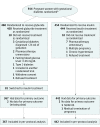Effect of Glyburide vs Subcutaneous Insulin on Perinatal Complications Among Women With Gestational Diabetes: A Randomized Clinical Trial
- PMID: 29715355
- PMCID: PMC6583037
- DOI: 10.1001/jama.2018.4072
Effect of Glyburide vs Subcutaneous Insulin on Perinatal Complications Among Women With Gestational Diabetes: A Randomized Clinical Trial
Abstract
Importance: Randomized trials have not focused on neonatal complications of glyburide for women with gestational diabetes.
Objective: To compare oral glyburide vs subcutaneous insulin in prevention of perinatal complications in newborns of women with gestational diabetes.
Design, settings, and participants: The Insulin Daonil trial (INDAO), a multicenter noninferiority randomized trial conducted between May 2012 and November 2016 (end of participant follow-up) in 13 tertiary care university hospitals in France including 914 women with singleton pregnancies and gestational diabetes diagnosed between 24 and 34 weeks of gestation.
Interventions: Women who required pharmacologic treatment after 10 days of dietary intervention were randomly assigned to receive glyburide (n=460) or insulin (n=454). The starting dosage for glyburide was 2.5 mg orally once per day and could be increased if necessary 4 days later by 2.5 mg and thereafter by 5 mg every 4 days in 2 morning and evening doses, up to a maximum of 20 mg/d. The starting dosage for insulin was 4 IU to 20 IU given subcutaneously 1 to 4 times per day as necessary and increased according to self-measured blood glucose concentrations.
Main outcomes and measures: The primary outcome was a composite criterion including macrosomia, neonatal hypoglycemia, and hyperbilirubinemia. The noninferiority margin was set at 7% based on a 1-sided 97.5% confidence interval.
Results: Among the 914 patients who were randomized (mean age, 32.8 [SD, 5.2] years), 98% completed the trial. In a per-protocol analysis, 367 and 442 women and their neonates were analyzed in the glyburide and insulin groups, respectively. The frequency of the primary outcome was 27.6% in the glyburide group and 23.4% in the insulin group, a difference of 4.2% (1-sided 97.5% CI, -∞ to 10.5%; P=.19).
Conclusion and relevance: This study of women with gestational diabetes failed to show that use of glyburide compared with subcutaneous insulin does not result in a greater frequency of perinatal complications. These findings do not justify the use of glyburide as a first-line treatment.
Trial registration: clinicaltrials.gov Identifier: NCT01731431.
Conflict of interest statement
Figures
Comment in
-
Insulin vs Glyburide for Gestational Diabetes.JAMA. 2018 May 1;319(17):1769-1770. doi: 10.1001/jama.2018.4561. JAMA. 2018. PMID: 29715338 No abstract available.
-
Needle beats pill in gestational diabetes mellitus.Nat Rev Endocrinol. 2018 Aug;14(8):448-449. doi: 10.1038/s41574-018-0050-0. Nat Rev Endocrinol. 2018. PMID: 29941947 No abstract available.
-
Glyburide vs Insulin for Gestational Diabetes.JAMA. 2018 Oct 2;320(13):1383-1384. doi: 10.1001/jama.2018.10086. JAMA. 2018. PMID: 30285169 No abstract available.
-
Pharmacotherapy for gestational diabetes mellitus: still insulin, or what about sulfonylureas?Ann Transl Med. 2018 Nov;6(Suppl 1):S79. doi: 10.21037/atm.2018.10.60. Ann Transl Med. 2018. PMID: 30613654 Free PMC article. No abstract available.
References
-
- Crowther CA, Hiller JE, Moss JR, McPhee AJ, Jeffries WS, Robinson JS; Australian Carbohydrate Intolerance Study in Pregnant Women Trial Group . Effect of treatment of gestational diabetes mellitus on pregnancy outcomes. N Engl J Med. 2005;352(24):2477-2486. - PubMed
-
- Simmons D, McElduff A, McIntyre HD, Elrishi M. Gestational diabetes mellitus: NICE for the US? a comparison of the American Diabetes Association and the American College of Obstetricians and Gynecologists guidelines with the UK National Institute for Health and Clinical Excellence guidelines. Diabetes Care. 2010;33(1):34-37. - PMC - PubMed
-
- Committee on Practice Bulletins—Obstetrics ACOG practice bulletin No. 190: gestational diabetes mellitus. Obstet Gynecol. 2018;131(2):e49-e64. - PubMed
Publication types
MeSH terms
Substances
Associated data
LinkOut - more resources
Full Text Sources
Other Literature Sources
Medical


